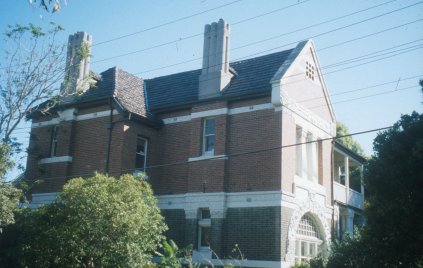|
|
|
Home | Introduction | Contents| Feedback | Map | Sources | Glossary |
|
28
The Priory (Former Boarding House Annexe, The Priory Ladies’ School)
The Priory, 2002
We publish this
week ... a house erected at
The style of
architecture of the new house is entirely new in these colonies, being
American Romanesque inside and out, and containing the newest features as Mr
Kilburn has only just returned from his trip to
So, The Builder &
Contractors’ News purred in 1890. Although there are several public
buildings here in American (or Richardsonian)
Romanesque, such as: the former South Yarra Post Office, 162 Toorak Road, South
Yarra (1892, A J McDonald), the Victorian Artists’ Society, 430 Albert Street,
East Melbourne (Richard Speight & H W
Tomkins, 1893 (21)) and Armadale Infants
School, Densham Road, Armadale (1901-02, S E
Bindley); all are later than The Priory. Houses in this style are rare, in
Apart from later terraced
houses in Park Street, South Yarra (1905) and Clarendon Street, East Melbourne
(c1905), The Priory and its slightly younger sister,
Cestria, 521 Glenferrie Road, Hawthorn (1891, E. G. Kilburn) are known
to be unique in
Edward George Kilburn
(1859-94) architect of The Priory, designed at least 30 houses alone, but in
1885, he joined William Henry Ellerker (d1891) in
partnership. Ellerker started with the Public Works
Department and found early success as second prize-winner in the major
competition for government school designs in 1873 (34). His Gothic design
was built as Lee Street Primary,
Their most extraordinary surviving building is the City of Melbourne (Building Society) Building at 112 Elizabeth Street (corner of Little Collins Street) built in 1888, and completed just before Kilburn’s trip to the USA, yet already with exuberant American influence, untamed and without the Chicago sophistication he showed at The Priory, on his return.
H. H. Richardson
(1838-86) whose work so influenced the design of The Priory, was the first
American architect of incontestable genius. He influenced Louis Sullivan, the
master of Frank Lloyd Wright and Walter Burley Griffin, the designer of
The Richardsonian Romanesque was a re-casting of the early French medieval architectural style, resurrected a thousand years later. At the Priory, the rugged stone is mocked up in cement render, in a fascinating cyclopean rustication over big Romanesque arches and internally, over the chimney pieces. First floor windows have stubby colonettes. The chimneys are most unusual, consisting of a bunch of four plain cylinders, tied with a decorative band, like an amulet. The gables also are unusual with curious rounded taps. The Priory was one of several girls private boarding, or day schools in St Kilda, including Oberwyl (1867-1931, (27), and Wattle House (1863-80? (23)). Hofwyl House Academy (1862-C20) is the only known St Kilda private school in the nineteenth century, open for boys. (44). These schools were fee-paying and received no government funding, or controlling interference. As early as 1872, J Morris owned Lansmere, a two-storied brick half-timbered house, with interesting Gothic arcading and elaborate barge-boards, somewhat like Wattle House (23), as well as the nine-roomed timber Sherwood Cottage next door. He used them both as a ‘collegiate academy’. Lansmere was sold in 1875, and leased to Reverend Backhouse, then from 1877, to Reverend Benjamin. Later they both became part of The Priory School. Lansmere is visible in the 1890 illustration of the newly constructed building, The Priory.
In 1983, The Priory was
purchased as a family home by the eminent Australian stage and costume designer
Kenneth Rowell. His brother, John Rowell was also an artist. Their mother,
Eugene Durran was the daughter of James
Durran, architect of the firm
Tombd & Durran, architects in Edwardian
Geelong. His brother was a landscape designer. Kenneth Rowell had been a young
painter and dancer in the Borovansky Ballet,
designing then for the Ballet Rambert of London, on
its first post-war tour to
Soon he was designing in
Kenneth Rowell’s career
continued in parallel in
References Atterton, Margot and Veitch, Alan. The Illustrated Encyclopaedia of Australian Showbiz. Sunshine Books, Brookvale NSW. 1984. p193.
Australasian Builder and Contractors’ News.
Bick, David with Wilson Sayer Core Pty. Ltd. St Kilda Study. Area 2. (Undated). pp 95-97.
Goad, Philip.
Heritage
Lewis, Miles. Architectural Survey.
Final Report.
Lewis, Miles. Melbourne Mansions. Database.
Sutherland, Alexander.
|
|
St Kilda Historical Society Inc. © 2005 |

